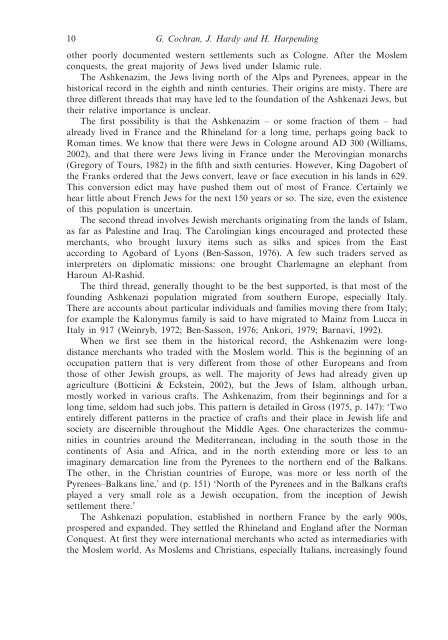natural history of ashkenazi intelligence - Henry C Harpending ...
natural history of ashkenazi intelligence - Henry C Harpending ...
natural history of ashkenazi intelligence - Henry C Harpending ...
Create successful ePaper yourself
Turn your PDF publications into a flip-book with our unique Google optimized e-Paper software.
10 G. Cochran, J. Hardy and H. <strong>Harpending</strong><br />
other poorly documented western settlements such as Cologne. After the Moslem<br />
conquests, the great majority <strong>of</strong> Jews lived under Islamic rule.<br />
The Ashkenazim, the Jews living north <strong>of</strong> the Alps and Pyrenees, appear in the<br />
historical record in the eighth and ninth centuries. Their origins are misty. There are<br />
three different threads that may have led to the foundation <strong>of</strong> the Ashkenazi Jews, but<br />
their relative importance is unclear.<br />
The first possibility is that the Ashkenazim – or some fraction <strong>of</strong> them – had<br />
already lived in France and the Rhineland for a long time, perhaps going back to<br />
Roman times. We know that there were Jews in Cologne around AD 300 (Williams,<br />
2002), and that there were Jews living in France under the Merovingian monarchs<br />
(Gregory <strong>of</strong> Tours, 1982) in the fifth and sixth centuries. However, King Dagobert <strong>of</strong><br />
the Franks ordered that the Jews convert, leave or face execution in his lands in 629.<br />
This conversion edict may have pushed them out <strong>of</strong> most <strong>of</strong> France. Certainly we<br />
hear little about French Jews for the next 150 years or so. The size, even the existence<br />
<strong>of</strong> this population is uncertain.<br />
The second thread involves Jewish merchants originating from the lands <strong>of</strong> Islam,<br />
as far as Palestine and Iraq. The Carolingian kings encouraged and protected these<br />
merchants, who brought luxury items such as silks and spices from the East<br />
according to Agobard <strong>of</strong> Lyons (Ben-Sasson, 1976). A few such traders served as<br />
interpreters on diplomatic missions: one brought Charlemagne an elephant from<br />
Haroun Al-Rashid.<br />
The third thread, generally thought to be the best supported, is that most <strong>of</strong> the<br />
founding Ashkenazi population migrated from southern Europe, especially Italy.<br />
There are accounts about particular individuals and families moving there from Italy;<br />
for example the Kalonymus family is said to have migrated to Mainz from Lucca in<br />
Italy in 917 (Weinryb, 1972; Ben-Sasson, 1976; Ankori, 1979; Barnavi, 1992).<br />
When we first see them in the historical record, the Ashkenazim were longdistance<br />
merchants who traded with the Moslem world. This is the beginning <strong>of</strong> an<br />
occupation pattern that is very different from those <strong>of</strong> other Europeans and from<br />
those <strong>of</strong> other Jewish groups, as well. The majority <strong>of</strong> Jews had already given up<br />
agriculture (Botticini & Eckstein, 2002), but the Jews <strong>of</strong> Islam, although urban,<br />
mostly worked in various crafts. The Ashkenazim, from their beginnings and for a<br />
long time, seldom had such jobs. This pattern is detailed in Gross (1975, p. 147): ‘Two<br />
entirely different patterns in the practice <strong>of</strong> crafts and their place in Jewish life and<br />
society are discernible throughout the Middle Ages. One characterizes the communities<br />
in countries around the Mediterranean, including in the south those in the<br />
continents <strong>of</strong> Asia and Africa, and in the north extending more or less to an<br />
imaginary demarcation line from the Pyrenees to the northern end <strong>of</strong> the Balkans.<br />
The other, in the Christian countries <strong>of</strong> Europe, was more or less north <strong>of</strong> the<br />
Pyrenees–Balkans line,’ and (p. 151) ‘North <strong>of</strong> the Pyrenees and in the Balkans crafts<br />
played a very small role as a Jewish occupation, from the inception <strong>of</strong> Jewish<br />
settlement there.’<br />
The Ashkenazi population, established in northern France by the early 900s,<br />
prospered and expanded. They settled the Rhineland and England after the Norman<br />
Conquest. At first they were international merchants who acted as intermediaries with<br />
the Moslem world. As Moslems and Christians, especially Italians, increasingly found


